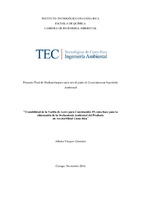Trazabilidad de la Varilla de Acero para Construcción #3 como base para la elaboración de la Declaratoria Ambiental del Producto en ArcelorMittal Costa Rica
Abstract
The construction industry aims to transform raw materials into semi-finished or finished products. Within this is the steel industry to which major environmental impacts are attributed due to the intensity of use of resources (materials and energy) during their raw material extraction, production processes and alike. To determine those impacts some methodologies are available such as Life-Cycle Assessment (LCA), which allows quantifying and assessing the potential environmental impacts associated with processes, products or services during all stages of its existence. LCA also serves as a basis for obtaining international environmental certifications such as Environmental Product Declaration (EPD), which provide quantified and verifiable information on the environmental performance of a product. The present study aims to determine the traceability of construction steel rod # 3 in the company ArcelorMittal Costa Rica for the stages of production and transportation of raw material and production and transportation of the steel rod; as a basis for DAP. An inventory of inputs and outputs of each stage of the life cycle was created which was evaluated by SimaPro 8.2.3 software, using the Ecoinvent databases. The results of the life cycle impact assessment (LCIA), revealed that the greatest potential environmental impacts of the entire system occurred at the stage of steel ingots production due to the raw materials. It was also determined that during the transport stage, the use of the train generates more impacts than the transport by boat per kilometer transporting a ton of material. For the rod production phase the biggest impacts associated are related to the gas emission from the furnace chimney. In the transport of the steel rode phase, it was demonstrated that there is a proportionality between the fuel consumed and the weight of product transported. Finally, it was determined that to address the information gap to reach the DAP of the steel rod, it is necessary to update the life cycle inventory with more accurate and updated information for the different life cycle stages in accordance with the certification process and perform a LCA with SimaPro professional license to provide a better assessment of the system under study.
Description
Proyecto de Graduación, (Licenciatura en Ingeniería Ambiental) Instituto Tecnológico de Costa Rica, Escuela de Química, 2016.


